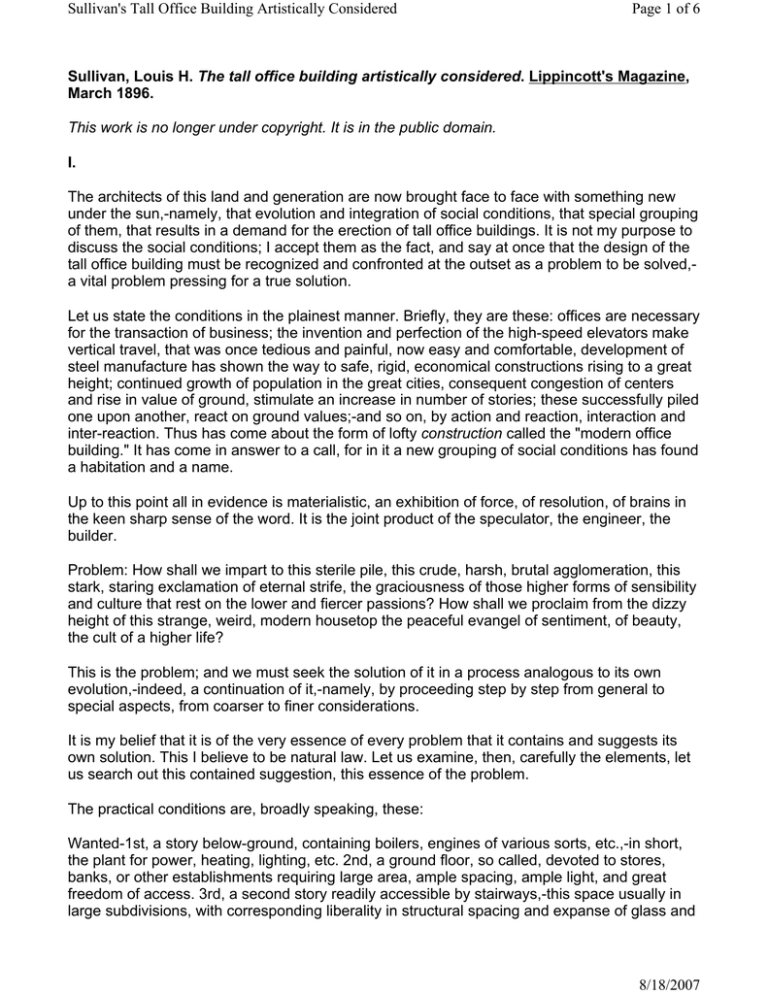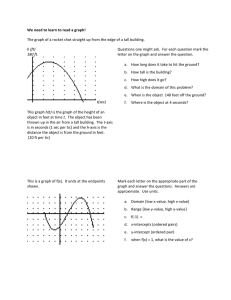Sullivan's Tall Office Building Artistically Considered Page 1 of 6
advertisement

Sullivan's Tall Office Building Artistically Considered Page 1 of 6 Sullivan, Louis H. The tall office building artistically considered. Lippincott's Magazine, March 1896. This work is no longer under copyright. It is in the public domain. I. The architects of this land and generation are now brought face to face with something new under the sun,-namely, that evolution and integration of social conditions, that special grouping of them, that results in a demand for the erection of tall office buildings. It is not my purpose to discuss the social conditions; I accept them as the fact, and say at once that the design of the tall office building must be recognized and confronted at the outset as a problem to be solved, a vital problem pressing for a true solution. Let us state the conditions in the plainest manner. Briefly, they are these: offices are necessary for the transaction of business; the invention and perfection of the high-speed elevators make vertical travel, that was once tedious and painful, now easy and comfortable, development of steel manufacture has shown the way to safe, rigid, economical constructions rising to a great height; continued growth of population in the great cities, consequent congestion of centers and rise in value of ground, stimulate an increase in number of stories; these successfully piled one upon another, react on ground values;-and so on, by action and reaction, interaction and inter-reaction. Thus has come about the form of lofty construction called the "modern office building." It has come in answer to a call, for in it a new grouping of social conditions has found a habitation and a name. Up to this point all in evidence is materialistic, an exhibition of force, of resolution, of brains in the keen sharp sense of the word. It is the joint product of the speculator, the engineer, the builder. Problem: How shall we impart to this sterile pile, this crude, harsh, brutal agglomeration, this stark, staring exclamation of eternal strife, the graciousness of those higher forms of sensibility and culture that rest on the lower and fiercer passions? How shall we proclaim from the dizzy height of this strange, weird, modern housetop the peaceful evangel of sentiment, of beauty, the cult of a higher life? This is the problem; and we must seek the solution of it in a process analogous to its own evolution,-indeed, a continuation of it,-namely, by proceeding step by step from general to special aspects, from coarser to finer considerations. It is my belief that it is of the very essence of every problem that it contains and suggests its own solution. This I believe to be natural law. Let us examine, then, carefully the elements, let us search out this contained suggestion, this essence of the problem. The practical conditions are, broadly speaking, these: Wanted-1st, a story below-ground, containing boilers, engines of various sorts, etc.,-in short, the plant for power, heating, lighting, etc. 2nd, a ground floor, so called, devoted to stores, banks, or other establishments requiring large area, ample spacing, ample light, and great freedom of access. 3rd, a second story readily accessible by stairways,-this space usually in large subdivisions, with corresponding liberality in structural spacing and expanse of glass and 8/18/2007 Sullivan's Tall Office Building Artistically Considered Page 2 of 6 breadth of external openings. 4th, above this an indefinite number of stories of offices piled tier upon tier, one tier just like another tier, one office just like all the other offices,-an office being similar to a cell in a honey-comb, merely a compartment, nothing more. 5th and last, at the top of this pile is placed a space or story that, as related to the life and usefulness of the structure, is purely physiological in its nature,-namely, the attic. In this the circulatory system completes itself and makes its grand turn, ascending and descending. The space is filled with tanks, pipes, valves, sheaves, and mechanical et cetera that supplement and complement the force originating plant hidden below-ground in the cellar. Finally, or at the beginning rather, there must be on the ground floor a main aperture or entrance common to all the occupants or patrons of the building. This tabulation is, in the main, characteristic of every tall office building in the country. As to the necessary arrangements for light courts. these are not germane to the problem, and, as will become soon evident, I trust, need not be considered here. These things, and such others as the arrangement of elevators, for example, have to do strictly with the economics of the building, and I assume them to have been fully considered and disposed of to the satisfaction of purely utilitarian and pecuniary demands. Only in rare instances does the plan or floor arrangement of the tall office building take on an aesthetic value, and this usually when the lighting court is external or becomes an internal feature of great importance. As I am here seeking not for an individual or special solution, but for a true normal type, the attention must be confined to those conditions that, in the main, are constant in all tall office buildings, and every mere incidental and accidental variation eliminated from the consideration, as harmful to the clearness of the main inquiry. The practical horizontal and vertical division or office unit is naturally based on a room of comfortable area and height, and the size of this standard office room as naturally predetermines the standard structural unit, and, approximately, the size of window-openings. In turn, these purely arbitrary units of structure form in an equally natural way the true basis of the artistic development of the exterior. Of course the structural spacings and openings in the first or mercantile story are required to be the largest of all; those in the second or quasimercantile story are of a somewhat similar nature. The spacings and openings in the attic are of no importance whatsoever (the windows have no actual value), for light may be taken from the top, and no recognition of a cellular division is necessary in the structural spacing. Hence it follows inevitably, and in the simplest possible way, that if we follow our natural instincts without thought of books, rules, precedents, or any such educational impedimenta to a spontaneous and "sensible" result, we will in the following manner design the exterior of our tall office building,-to wit: Beginning with the first story, we give this a main entrance that attracts the eye to its location, and the remainder of the story we treat in a more or less liberal, expansive, sumptuous way,-a way based exactly on the practical necessities, but expressed with a sentiment of largeness and freedom. The second story we treat in a similar way, but usually with milder pretension. Above this, throughout the indefinite number of typical office tiers, we take our cue from the individual cell, which requires a window with its separating pier, its sill and lintel, and we, without more ado, make them look all alike because they are all alike. This brings us to the attic, which, having no division into office-cells, and no special requirement for lighting, gives the power to show by means of its broad expanse of wall, and its dominating weight and character, that which is the fact,-namely, that the series of office-tiers has come definitely to an 8/18/2007 Sullivan's Tall Office Building Artistically Considered Page 3 of 6 end. This may perhaps seem a bald result and a heartless, pessimistic way of stating it, but even so we certainly have advanced a most characteristic stage beyond the imagined sinister building of the speculator-engineer- builder combination. For the hand of the architect is now definitely felt in the decisive position at once taken, and the suggestion of a thoroughly sound, logical, coherent expression of the conditions is becoming apparent. When I say the hand of the architect, I do not mean necessarily the accomplished and trained architect. I mean only a man with a strong, natural liking for buildings, and a disposition to shape them in what seems to his unaffected nature a direct and simple way. He will probably tread an innocent path from his problem to its solution, and therein he will show an enviable gift of logic. If he have some gift for form in detail, some love for that, his result in addition to its simple straightforward naturalness and completeness in general statement, will have something of the charm of sentiment. However, thus far the results are only partial and tentative at best; relatively true, they are but superficial. We are doubtless right in our instinct but we must seek a fuller justification, a finer sanction, for it. II. I assume now that in the study of our problem we have passed through the various stages of inquiry, as follows: 1st, the social basis of the demand for tall office buildings; 2nd, its literal material satisfaction; 3rd, elevation of the question from considerations of literal planning, construction, and equipment, to the plane of elementary architecture as a direct outgrowth of sound, sensible building; 4th, the question again elevated from an elementary architecture to the beginnings of true architectural expression, through the addition of a certain quality and quantity of sentiment. But our building may have all these in a considerable degree and yet be far from the adequate solution of the problem I am attempting to define. We must now heed the imperative voice of emotion. It demands of us, What is the chief characteristic of the tall office building? And at once we answer, it is lofty. This loftiness is to the artist-nature its thrilling aspect. It is the very open organ-tone in its appeal. It must be in turn the dominant chord in his expression of it, the true excitant of his imagination. It must be tall, every inch of it tall. The force and power of altitude must be in it the glory and pride of exaltation must be in it. It must be every inch a proud and soaring thing, rising in sheer exultation that from bottom to top it is a unit without a single dissenting line,-that it is the new, the unexpected, the eloquent peroration of most bald, most sinister, most forbidding conditions. The man who designs in this spirit and with the sense of responsibility to the generation he lives in must be no coward, no denier, no bookworm, no dilettante. He must live of his life and for his life in the fullest, most consummate sense. He must realize at once and with the grasp of inspiration that the problem of the tall office building is one of the most stupendous, one of the most magnificent opportunities that the Lord of Nature in His beneficence has ever offered to the proud spirit of man. 8/18/2007 Sullivan's Tall Office Building Artistically Considered Page 4 of 6 That this has not been perceived-indeed, has been flatly denied-is an exhibition of human perversity that must give us pause. III. One more consideration: Let us now lift this question into the region of calm, philosophic observation. Let us seek a comprehensive, a final solution: let the problem indeed dissolve. Certain critics, and very thoughtful ones, have advanced the theory that the true prototype of the tall office building is the classical column, consisting of base, shaft and capital,-the molded base of the column typical of the lower stories of our building, the plain or fluted shaft suggesting the monotonous, uninterrupted series of office-tiers, and the capital the completing power and luxuriance of the attic. Other theorizers assuming a mystical symbolism as a guide, quote the many trinities in nature and in art, and the beauty and conclusiveness of such trinity in unity. They aver the beauty of prime numbers, the mysticism of the number three, the beauty of all things that are in three parts,-to wit, the day, subdividing into morning, noon, and night; the limbs, the thorax, and the head, constituting the body. So they say, should the building be in three parts vertically, substantially as before, but for different motives. Others, of purely intellectual temperament, hold that such a design should be in the nature of a logical statement; it should have a beginning, a middle, and an ending, each clearly defined, therefore again a building, as above, in three parts vertically. Others, seeking their examples and justification in the vegetable kingdom. urge that such a design shall above all things be organic. They quote the suitable flower with its bunch of leaves at the earth, its long graceful stem, carrying the gorgeous single flower. They point to the pinetree,-its messy roots, its lithe, uninterrupted trunk, its tuft of green high in the air. Thus, they say, should be the design of the tall office building: again in three parts vertically. Others still, more susceptible to the power of a unit than to the grace of a trinity, say that such a design should be struck out at a blow, as though by a blacksmith or by mighty Jove, or should be thought-born, as was Minerva, full-grown. They accept the notion of a triple division as permissible and welcome, but non-essential. With them it is a subdivision of their unit; the unit does not come from the alliance of the three; they accept it without murmur, provided the subdivision does not disturb the sense of singleness and repose. All of these critics and theorists agree, however, positively, unequivocally, in this, that the tall office building should not, must not, be made a field for the display of architectural knowledge in the encyclopedic sense; that too much learning in this instance is fully as dangerous, as obnoxious, as too little learning; that miscellany is abhorrent to their sense; that the sixteenstory building must not consist of sixteen separate, distinct, and unrelated buildings piled one upon the other until the top of the pile is reached. To this latter folly I would not refer were it not the fact that nine out of every ten tall office buildings are designed in precisely this way in effect, not by the ignorant, but by the educated. It would seem, indeed, as though the "trained" architect, when facing this problem, were beset at every story, or, at most, every third or forth story, by the hysterical dread lest he be in "bad form;" lest he be not bedecking his building with sufficiency of quotation from this, that, or the 8/18/2007 Sullivan's Tall Office Building Artistically Considered Page 5 of 6 other "correct" building in some other land and some other time; lest he be not copious enough in the display of his wares; lest he betray, in short, a lack of resources. To loosen up the touch of this cramped and fidgity hand, to allow the nerves to calm, the brain to cool, to reflect equably, to reason naturally, seems beyond him; he lives, as it were, in a waking nightmare filled with the disjecta membra of architecture. The spectacle is not inspiriting. As to the former and serious views held by discerning and thoughtful critics, I shall, with however much of regret, dissent from them for the purpose of this demonstration, for I regard them as secondary only, non-essential, and as touching not at all upon the vital spot, upon the quick of the entire matter, upon the true, the immovable philosophy of the architectural art. This view let me now state, for it brings to the solution of the problem a final, comprehensive formula: All things in nature have a shape, that is to say, a form, an outward semblance, that tells us what they are, that distinguishes them from ourselves and from each other. Unfailingly in nature these shapes express the inner life, the native quality, of the animal, tree, bird, fish, that they present to us; they are so characteristic, so recognizable, that we say simply, it is "natural" it should be so. Yet the moment we peer beneath this surface of things, the moment we look through the tranquil reflection of ourselves and the clouds above us, down into the clear, fluent, unfathomable depth of nature, how startling is the silence of it, how amazing the flow of life, how absorbing the mystery! Unceasingly the essence of things is taking shape in the matter of things, and this unspeakable process we call birth and growth. Awhile the spirit and the matter fade away together, and it is this that we call decadence, death. These two happenings seem jointed and interdependent, blended into one like a bubble and its iridescence, and they seem borne along upon a slowly moving air. This air is wonderful past all understanding. Yet to the steadfast eye of one standing upon the shore of things, looking chiefly and most lovingly upon that side on which the sun shines and that we feel joyously to be life, the heart is ever gladdened by the beauty, the exquisite spontaneity, with which life seeks and takes on its forms in an accord perfectly responsive to its needs. It seems ever as though the life and the form were absolutely one and inseparable, so adequate is the sense of fulfillment. Whether it be the sweeping eagle in his flight, or the open apple-blossom, the toiling work horse, the blithe swan, the branching oak, the winding stream at its base, the drifting clouds, over all the coursing sun, form ever follows function, and this is the law. Where function does not change form does not change. The granite rocks, the ever-brooding hills, remain for ages; the lightning lives, comes into shape, and dies in a twinkling. It is the pervading law of all things organic and inorganic, of all things physical and metaphysical, of all things human and all things superhuman, of all true manifestations of the head, of the heart, of the soul, that the life is recognizable in its expression, that form ever follows function. This is the law. Shall we, then, daily violate this law in our art? Are we so decadent, so imbecile, so utterly weak of eyesight, that we cannot perceive this truth so simple, so very simple? Is it indeed a truth so transparent that we see through it but do not see it? It is really then, a very marvelous thing, or is it rather so commonplace, so everyday, so near a thing to us, that we cannot 8/18/2007 Sullivan's Tall Office Building Artistically Considered Page 6 of 6 perceive that the shape, form, outward expression, design, or whatever we may choose, of the tall office building should in the very nature of things follow the functions of the building, and that where the function does not change, the form is not to change? Does this not readily, clearly, and conclusively show that the lower one or two stories will take on a special character suited to the special needs, that the tiers of typical offices, having the same unchanging function, shall continue in the same unchanging form, and that as to the attic, specific and conclusive as it is in its very nature, its function shall equally be so in force, in significance, in continuity, in conclusiveness of outward expression? From this results, naturally, spontaneously, unwittingly, a three-part division,-not from any theory, symbol, or fancied logic. And thus the design of the tall office building takes its place with all other architectural types made when architecture, as has happened once in many years, was a living art. Witness the Greek temple, the Gothic cathedral, the mediaeval fortress. And thus, when native instinct and sensibility shall govern the exercise of our beloved art; when the known law, the respected law, shall be that form ever follows function; when our architects shall cease strutting and prattling handcuffed and vainglorious In the asylum of a foreign school; when it is truly felt, cheerfully accepted, that this law opens up the airy sunshine of green fields, and gives to us a freedom that the very beauty and sumptuousness of the outworking Of the law itself as exhibited in nature will deter any sane, any sensitive man from changing into license; when it becomes evident that we are merely speaking a foreign language with a noticeable American accent, whereas each and every architect in the land might, under the benign influence of this law, express in the simplest, most modest, most natural way that which il is in him to say: that he might really and would surely develop his own characteristic individuality, and that the architectural art with him would certainly become a living form of speech, a natural form of utterance, giving surcease to him and adding treasures small and great to the growing art of his land; when we know and feel that Nature is our friend, not our implacable enemy,-that an afternoon in the country, an hour by the sea, a full open view of one single day, through dawn, high noon, and twilight, will suggest to us so much that is rhythmical, deep, and eternal in the vast art of architecture, something so deep, so true, that all the narrow formalities, hard-and-fast rules, and strangling bonds of the schools cannot stifle it in us,-then it may be proclaimed that we are on the high-road to a natural and satisfying art, an architecture that will soon become a fine art in the true, the best sense of the word, an art that will live because it will be of the people, for the people, and by the people. 8/18/2007 MIT OpenCourseWare http://ocw.mit.edu 4.205 Analysis of Contemporary Architecture Fall 2009 For information about citing these materials or our Terms of Use, visit: http://ocw.mit.edu/terms.






